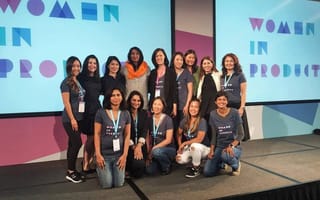
Tech built by a homogenous product team may cause nausea, disorientation and dizziness.
Really.
When virtual reality headsets were first introduced, research published in the Frontiers in Robotics and AI, a peer-reviewed journal, found that higher numbers of women who used the products suffered from severe motion sickness. Nisha Victor, VP of Product Management at Upwork, points to this as a prime example of how a lack of diversity within product teams can have an adverse effect on users.
“Women tend to have a narrower distance between their pupils than men do,” Victor said, citing a finding from the report. “Most of those VR headsets were calibrated to fit a wider distance between pupils, which meant they were designed more effectively and safely for men. Had the headsets been tested on a wider group of users before releasing them, they might have been more inclusive products.”
Inclusive technology is about building products that are representative of all our customers and all the people we hope will want to use our products.”
The concept of inclusive tech, or building products designed to benefit every user, is an area Victor is passionate about. Her team designs products for many users — and she doesn’t want to leave a single one out.
“Inclusive technology is about building products that are representative of all our customers and all the people we hope will want to use our products,” Victor said. “It is about making sure that we are not designing products under the assumption that every customer fits a similar mold, which could inadvertently cause pain to an overlooked set of users.”
It’s a challenge, but one Victor gladly accepts. She said that building inclusive tech not only ensures more people can enjoy the product, but it actually raises the overall quality for everyone. Built In Chicago connected with the product leader to learn how she goes about building inclusive tech, why fostering a diverse team leads to more effective products and how Upwork is creating a better experience for users and employees alike.
How does inclusive technology benefit everyone?
There are many examples of how products designed for a specific audience went on to benefit every user.
Take audiobooks, which began as a project started by the American Foundation for the Blind in the 1930s and recorded books onto vinyl records. Up until then, if a person with a visual impairment wanted to read a book, they had to find someone to read it to them.
Today, digital audiobooks benefit far more users than people who have trouble seeing: A person commuting by car can safely consume a book while driving, people can exercise while listening and kids who don’t know how to read yet don’t have to wait for an older sibling or an adult to be available.
Inclusion from day one
What is Upwork doing to ensure the needs of all users are met?
As we build products, we assemble cross-functional teams that include people focused on a variety of disciplines: analytics, customer success, marketing, engineering, design, user research and product management. We all sit down together to look at the research we’ve done that helps us understand our customers’ problems. If we’ve done our jobs right, we’ve heard from a broad range of customers and are looking at the many facets of our customer base.
Then, by bringing in folks who hold different perspectives and come from different backgrounds to discuss the solution or strategy, we ensure that we examine all facets and don’t overlook something that might be critical to designing a product that accommodates those diverse inputs and is truly innovative.
Those different perspectives make us stronger as a team and as a result, our products become stronger, too.
What special considerations do you and other product leaders need to have to build inclusive tech?
Even when product designers are tapping into their empathy for user communities, they may struggle to set aside their own life experiences. To compensate for these types of biases, I ask designers and technologists on my teams to design with people rather than for them.
The team has to reflect on its biases, then identify and build relationships with people who are traditionally excluded from the product development process. We have to listen to our users, trust their knowledge, lived experiences and perspectives as outsiders, and use that information to direct product strategy and development.
It is the job of product leaders to empower our user communities to make product decisions — not just validate them. That’s when product design becomes powerfully inclusive. That’s when real innovation happens and when customers’ delight compels them to share their experiences with the product. Though we may not have a representative from every customer group at the design table, we must seize the opportunity to get creative with ways to bring as much representation into the process as possible.
What happens when a team’s diversity and inclusion efforts fail?
How does Upwork build inclusive teams?
At Upwork, our talent acquisition team has built a successful, inclusive hiring strategy on four principles: candidate focus, consistency, coordination and courage.
When we focus on the candidates, we dedicate ourselves to bringing out the best in each of them. By centering their needs, we allow ourselves to accurately see their potential. As soon as we know we need to fill a particular role, we’re already thinking about how to clearly communicate our culture and our values.
We build consistency into the process by ensuring every candidate has the same experience. We establish standards, hiring stages and assessments before the first candidate comes in the door. We invest the time upfront to get teams in formation so they’re ready to work together before we assemble the candidate pool. We take our candidates’ time and talent seriously.
Finally, we show courage by holding each other accountable. We call each other in and correct our process when we notice others on the team taking shortcuts, manifesting biases or making incorrect assumptions.
Bringing Women In Product Together
What’s one of the most important lessons you’ve learned as a product leader building inclusive tech?
I’ve learned that, as a product leader, I am in control of how I react and respond — whether that’s to my colleagues, to the marketplace or to my customers and users. I can choose to be empathetic and inclusive and support work that improves the world in which we live.
That curiosity to learn another’s perspective, that commitment to bridge differences — those are the qualities that allow us to use design thinking to build truly innovative, inclusive technology. By doing that, we ensure our work and our workplaces transform the landscape of tech.









